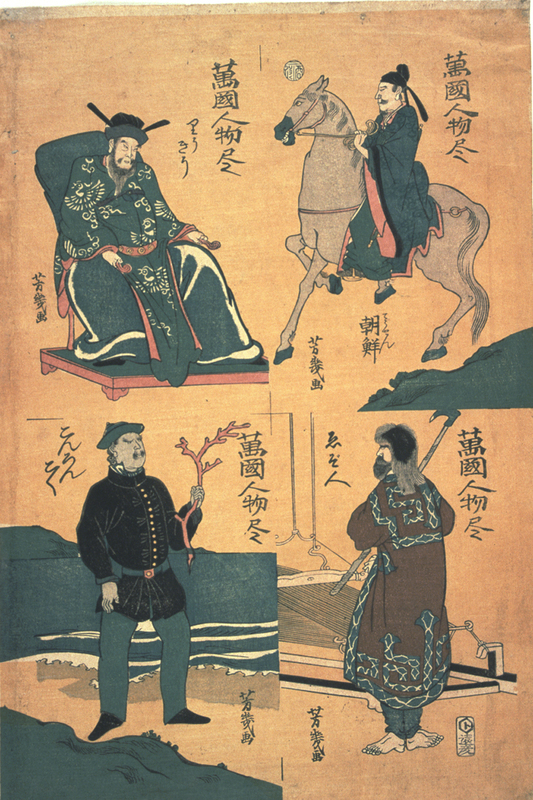Ainu Yokohama-e
After Japan was “opened” to international commerce in 1853, new trading ports like Yokohama were established throughout the country. Yokohama’s travelers visiting from abroad and international commodities were of great interest to local residents, and scenes of foreign people, places, goods, and customs became a favorite subject of Bakumatsu1 (late Edo period, 1853-1867) and early Meiji woodblock prints called Yokohama-e. Trained by the renowned master Utagawa Kuniyoshi (1798-1861), Utagawa Yoshiiku (1833-1904), the creator of this print, was among the first generation of Yokohama-e designers and played an important part in the development of the genre.2
This print, entitled Enumeration of People of All Nations, tunes into the national zeitgeist of globalization and openness by depicting four individuals of different cultures in close proximity to Japan. The top left figure appears to be a Ryukyu nobleman. While incorporated into the Japanese empire during the Meiji era, the Ryukyu Islands had historically been a tributary of China, and Chinese cultural influences can be seen in the man’s upright chair and Chinese-inspired robe. Next to him is an image of well-to-do scholarly gentleman (yangban) from Korea. Like the Ryukyus, nineteenth century Korea was also a Chinese tributary, and Chinese influences can be seen in the man’s elite robes and headdress.
The bottom-left figure seems to be a merchant from “Kunlun.” While “Kunlun” can refer to a number of geographic and mythological locales, here it likely refers to the Banda Islands of Indonesia. This region was the center of Malay, Dutch, Portuguese, and Chinese contact, and elements from these cultures are reflected in this man’s garments and appearance.3 Finally, on the bottom right of the print is an Ainu man wearing traditional embroidered garments. While the Japanese had been trading with the Ainu for centuries, as a culturally distinct society living in the ill-defined border regions of the north, the Ainu were a popular subject of Japanese paintings and prints, and their unique clothing and customs were regarded as fascinating and “exotic” by many in Edo and Meiji Japan. While this print tunes in to the general early-Meiji interest in all things foreign by imagining these scenes of Japan’s “unusual” neighbors, it is worth noting that all of these communities—the Ainu and Ryukyuans, Koreans and the Maluku people—would ultimately come under the colonial influence of Japan between the 1870s and the 1940s.
1.) The very late Edo period, 1853-1867.
2.) Alistair Swale, “Gesaku and the Renegotiation of ‘Civilization and Enlightenment’ through Illustrated News,” Japan Forum (Oxford, England) (2020): 3.
3.) Edward Schafer, The Golden Peaches of Samarkand: A Study of Tʻang Exotics, (Berkeley, C.A.: University of California Press, 1963): 46.
